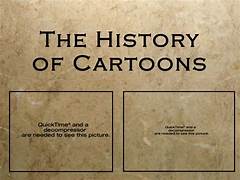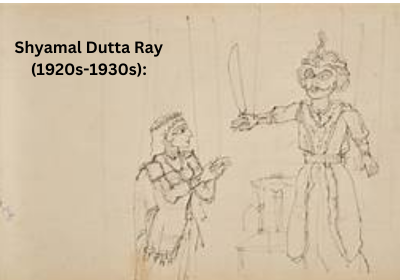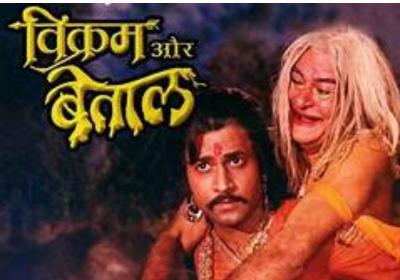The history of cartoons in India spans over a century, blending influences from traditional Indian art forms, Western animation techniques, and evolving cultural narratives. Here’s a detailed overview of how cartoons and animation developed in India:

1. Early Beginnings: Pre-Independence Era
- Traditional Art Forms: Before modern cartoons, India had rich storytelling traditions using puppetry, shadow plays, and murals (e.g., Warli and Madhubani art). These were precursors to animated storytelling.
- Shyamal Dutta Ray (1920s-1930s):
- The earliest political and satirical cartoons began appearing in Indian newspapers during the British colonial era.
- Cartoonists like Shankar Pillai (Shankar’s Weekly) used humor to critique colonial rule.

- First Animated Efforts:
- In 1934, Indian animator Dhundiraj Govind Phalke (known as Dadasaheb Phalke, the father of Indian cinema) created Agkadyanchi Mouj (The Matchsticks’ Fun), an early experimental stop-motion animation.
2. The Golden Age: 1950s-1980s
- Shankar’s Weekly (1948):
- Cartoonist K. Shankar Pillai popularized editorial cartoons after independence, using them as tools for social and political commentary.
- First Indian Animated Film:
- The Banyan Deer (1957): A collaboration between Indian animators and Western influences, funded by Films Division of India.
- Produced by Clair Weeks, a Disney animator, this film is based on a Buddhist Jataka tale and marked the beginning of formal animation in India.
- Films Division and Government Role:
- The government-backed Films Division encouraged the production of educational and animated films, often focused on public service messages (e.g., family planning, hygiene).
- Ram Mohan: Father of Indian Animation:
- Animator Ram Mohan led iconic projects and was instrumental in developing India’s animation industry.
- Ek Anek Aur Ekta (1974): A short educational animation about unity, known for its memorable song “Ek Chidiya Anek Chidiya”, became iconic.
3. Rise of Television: 1980s-1990s
- Doordarshan Era:
- The advent of television in India in the 1980s expanded the reach of cartoons and animation.
- Early animated content included educational and entertaining shorts, such as:
- Vikram Aur Betaal: A live-action and animated mix based on Indian folklore.
- Ek Titli Anek Titliyan (1981): A short promoting environmental awareness.

- Hand-Drawn Cartoons:
- Newspaper comics and cartoonists like R.K. Laxman gained immense popularity. The Common Man became a cultural icon.
- First Animated TV Series:
- Ghayab Aya (1986): Created by Suddhasattwa Basu, it was one of India’s first animated TV shows.
4. Boom of Indian Cartoons: 1990s-2000s
- Introduction of Satellite TV:
- Channels like Cartoon Network, Pogo, and Nickelodeon brought international animated shows (e.g., Tom and Jerry, Popeye, and Dexter’s Laboratory) to Indian households.
- Inspired by global content, Indian animators began creating localized content.
- Milestone Projects:
- Chhota Bheem (2008): Pioneered by Green Gold Animation, it became one of India’s most successful homegrown cartoon series.
- Motu Patlu: Another highly popular series, inspired by the comic strip Lotpot.
- Collaborations with International Studios:
- Indian studios like Toonz Animation, Crest Animation, and Pentamedia Graphics started co-producing content with global companies.
5. Digital Age: 2010s-Present
- Explosion of Animation Studios:
- Studios like Green Gold, DQ Entertainment, and Graphiti Multimedia began creating content for global platforms.
- India also became a hub for outsourced animation for major companies like Disney, DreamWorks, and Nickelodeon.
- OTT Platforms:
- Platforms like Netflix, Amazon Prime, and YouTube introduced new Indian animated shows, e.g., Mighty Little Bheem (2019), a spin-off of Chhota Bheem, which gained international acclaim.
- Diverse Content:
- Themes in modern Indian animation range from mythology (Little Krishna, Hanuman) to humor and adventure (Roll No. 21).
- Emerging Trends:
- Use of CGI and 3D animation for children’s shows.
- Short films and independent projects (e.g., True Love Story, Bombay Rose) that reflect Indian socio-cultural themes.
6. Key Cartoonists and Animators in India
- R.K. Laxman: Created The Common Man, a satirical representation of everyday Indians.
- Mario Miranda: Known for humorous sketches and caricatures.
- Ram Mohan: Pioneered animation in India, working on projects like Ramayana: The Legend of Prince Rama (1992).
- Kireet Khurana: Directed award-winning animated films like Delhi Safari (2012).
7. Challenges and Future Outlook
- Challenges:
- Budget constraints compared to Hollywood.
- Limited original content due to reliance on outsourcing work.
- Opportunities:
- Growing demand for regional-language animation.
- Increased accessibility to animation tools and software.
- Rising popularity of Indian stories and mythology in global markets.
Indian cartoons have come a long way, evolving from hand-drawn animations to sophisticated CGI productions, while staying rooted in the country’s rich storytelling traditions. With the rise of digital platforms and global collaborations, the future of Indian animation looks promising.
Also Read :
